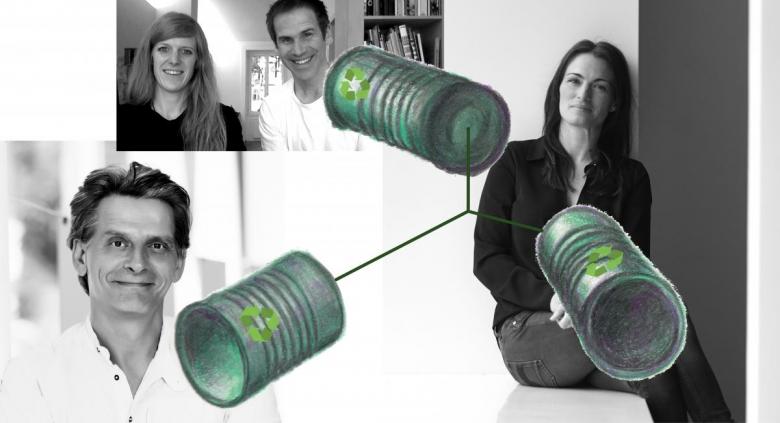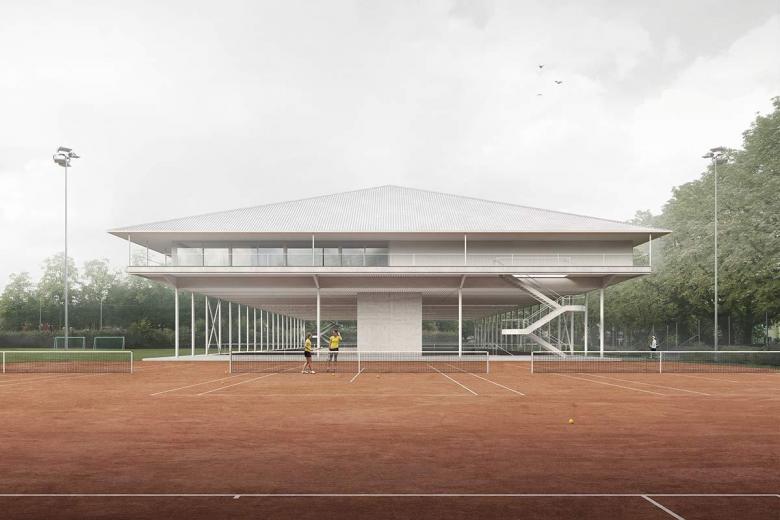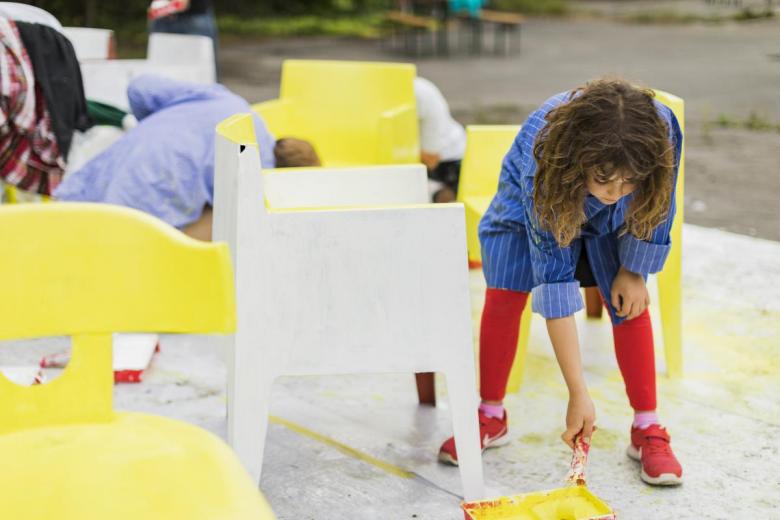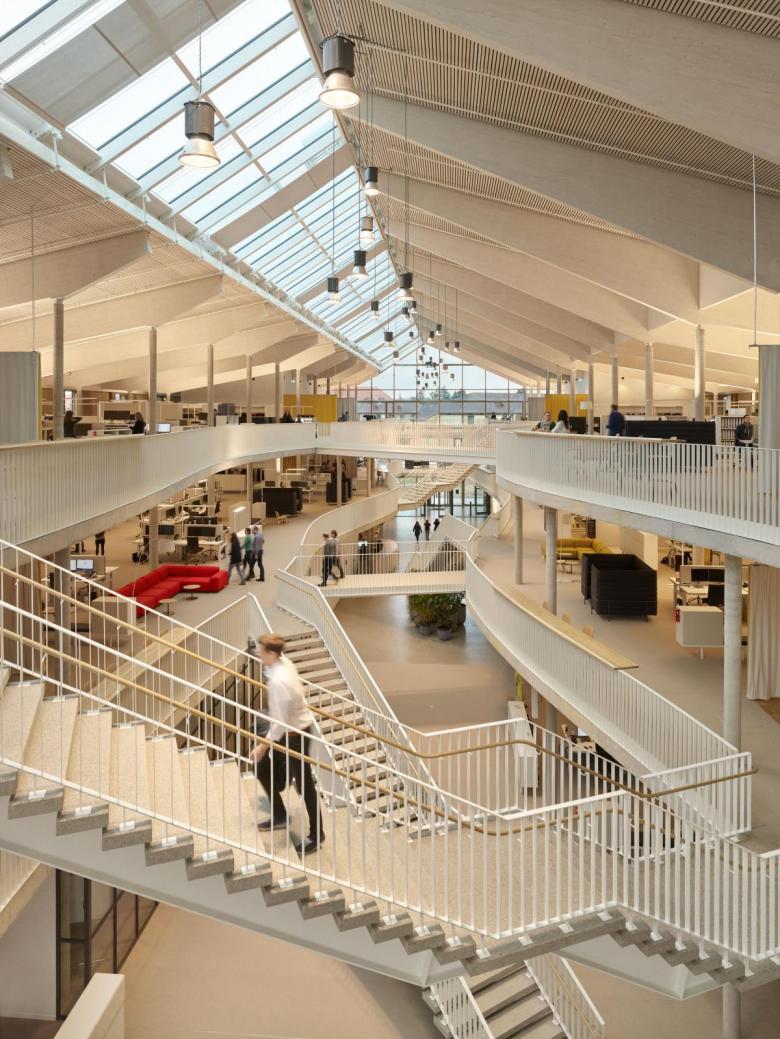Between Emergency and Opportunity
Elias Baumgarten
30. December 2021
Image: World-Architects
Between April and December, in the midst of the coronavirus pandemic, Swiss-Architects editor Elias Baumgarten interviewed a slew of German, Austrian, and Swiss architects: virtual conversations that were transcribed into the five-part D-A-CH Talks series. The fifth conversation is translated here since its subject — climate change — is considered by many to be the next crisis for humanity to address after the coronavirus is under control, and since the insight coming from the D-A-CH countries can apply to a global context.
To address how architects can contribute to averting the climate catastrophe and create a people- and environmentally friendly building culture, Baumgarten spoke with four architects in the last of the five D-A-CH Talks: Friederike Kluge and Meik Rehrmann are directors of the Basel architecture office Alma Maki and co-founders of Countdown 2030, a group of architects examining the impact of their professional actions on climate change; Verena Konrad is director of the Vorarlberg Architecture Institute based in Dornbirn, Austria; and Martin Haas is a principal of the architecture firm haas cook zemmrich STUDIO2050 and co-founder and vice-president of the German Sustainable Building Council (DGNB).
Elias Baumgarten: Although the topic has recently been pushed somewhat into the background, climate change is nevertheless attracting more and more political and social attention. This sometimes produces strange effects; at the last Swissbau trade fair, for example, almost every product was advertised as being particularly climate-friendly. In my work, I come across projects that are very progressive and those that don't seem very contemporary in terms of climate policy. Martin, you are active at the forefront of a sustainable building culture. How far have we progressed on the path to more far-sighted, responsible building?
Martin Haas: Energy-efficient building began 15 years ago. Today, energy-optimized buildings are the new normal. But they have not contributed to a different kind of building culture. Little has changed in terms of appearance, content and function. We have to realize that energy-efficient buildings have little impact in terms of climate policy because their positive effects are swallowed up by the current building boom.
In Germany, we still quantify energy consumption instead of qualifying it. But the most energy-efficient building is of little use if only three people live in it. It's time to take the next step and consider sustainability holistically. In my work for the German Sustainable Building Council (DGNB), I observe that the majority of us are not yet doing that. Many of us still focus on energy efficiency. We should be asking ourselves: how do we achieve high utilization rates for our buildings around the clock? Are the typological distinctions of the 20th century still appropriate? What is the state of the ecological assessment of our buildings over their entire life cycle — including construction, demolition and incorporated energy? We need to have a fundamental discussion about building law, about liability, use, ownership structures and responsibilities since holistic solutions are still failing because of all these factors.
Friederike Kluge: We can strongly identify with this position! We are interested in projects that manage to think of sustainability as a fundamental architectural concept. Sustainability should not be imposed on a project by a specialist planner afterwards. That doesn't work! We want to be inspired by climate and biodiversity issues and are interested in conversion, optimizing use and the developing small, efficient floor plans. Our generation needs to change its thinking because we know that the time for clean sweep concepts is over. The building culture is changing. We are looking for new solutions that promote climate and biodiversity. But although we have already learned a lot, we still feel that we are only at the beginning of our engagement with this topic. That is bitter, because time is pressing.
Our generation needs to change its thinking because we know that the time for clean sweep concepts is over. The building culture is changing. We are looking for new solutions that promote climate and biodiversity.
But to take up your question, Elias: In general, there is still a lot of explanatory work to be done. Knowledge about ecologically responsible building basically exists, but there is still too little of it in the architecture scene, or it is very unevenly distributed. For too long, many of us have not listened enough to the scientists or have not recognized our own possibilities for action and our responsibility. We have been too busy with other things. I find the view of architectural journalism, communication of architecture and also architecture awards very telling: Some articles, exhibitions and awards testify to profound knowledge, but too many are still uncritical or even engage in greenwashing — without even realizing it. If you look at projects from the perspective of future viability, highly questionable examples are often applauded. We, together with like-minded people, are therefore committed to the Countdown 2030 project, in order to provide impetus, point out necessities and, above all, to share knowledge and make it accessible. We don't want to raise an accusing finger, but rather want to motivate people to see the opportunities that open up when they take a different approach. We live in an exciting time, because we must and may rethink architecture and living space.
Verena Konrad: Thank you for your criticism, Friederike, which you already put forward very pointedly at the founding of Countdown 2030. Elias, we should respond to that in a moment. But first I would like to address your initial question: In Vorarlberg we had a very active ecological movement in the 1960s, which had an effect right into the 1980s. But in the 1990s and 2000s, awareness of the problem declined significantly. Why? I guess because of the growth orientation in the building industry as a whole. As in all areas of life, economic and ecological considerations seem to be in conflict. Today, there is a renewed interest in climate-friendly construction in our region — yet often, unfortunately, it is very much focused on details. As an architecture mediator, I want to work toward a holistic approach. In addition to my work at the Vorarlberg Architecture Institute (vai), I am also on the board of the EnergieinstitutVorarlberg (EIV). It is important to me not to lose sight of the big picture and to discuss different approaches and solutions. When we go on excursions, we visit, for example, the Cree company, a subsidiary of Rhomberg Bau that produces wooden modules, as well as the well-known 2226 project by Baumschlager Eberle nearby, which works without heating and cooling. There are many ways to focus on a goal.
Alma Maki, Old Boys Tennis Club Basel, entry to an invited competition, 2018 (Visualization: OS Images)
Baumgarten: Over the last year and a half, climate change has gained tremendously in importance in the political discourse, and the environmental movement is enjoying huge popularity, especially among young people. More and more people are addressing the issue — even though I doubt that they are ready to fundamentally change their lifestyle and, for example, give up their cars, smartphones, ever-new clothes or holiday trips. Doesn't this increased attention nevertheless help to develop and implement more sustainable architecture? Matthias Hein, for example, said at our third D-A-CH meeting that there are now property developers who consider climate architecture a good sales argument. Hermann Kaufmann also told me recently that there is a growing interest in sustainable buildings among investors.
Haas: Quite simply: As long as you can earn money by sheer building without thinking, nothing will change. In 1998, we implemented the first building with ceilings using component activation for Norddeutsche Landesbank. The late 1990s were a time of crisis; we faced a recession in Germany. At that time, companies were very open to new solutions — well, necessity is the mother of invention. In recent years, however, we have experienced a boom. In two recent timber construction projects, we were unable to find suitable companies willing to develop new solutions with us. Extra work is not attractive in phases of economic boom.
At the DGNB, I see that there is actually great potential: In Germany, we have many architects who could design a climate-neutral house overnight. But they don't do much with their knowledge, and demand is also low. We absolutely have to go into politics! We are in the midst of an epochal change. Classic industrial culture is coming to an end, and sustainability is nothing more than a sad term for society's search for new ethics. To me, this is completely lost in the architectural debate. We now have a unique opportunity, similar to the early 20th century, to put an architectural stamp on a new zeitgeist. But we have no answers to current social issues. I don't see any forward-looking concepts. Instead, we are adapting outdated architectural forms to contemporary technological issues. Basically, we are still living in the modern age. Sustainability is not a planning issue, not an energy issue, and not even an ecological issue, but it is a social-ethical one. I am in favor of expanding our concept of democracy to include the future: We should finally ask ourselves whether we can expect future generations to put up with our actions.
Meik Rehrmann: This is all very true, but it presupposes that a profound rethink takes place. Our way of doing business is entirely geared to growth. Companies want to produce and sell as much as possible. What interest should the economy have in building in simpler ways and as little as possible?
Haas: You're right, our economic system is the strongest opponent of a sustainable building culture. Nevertheless, I am optimistic. Recently, I was in Brussels at a meeting of major reinsurers. I was amazed by the discussions that took place: At some point, they said, someone will ask about the responsibility for the negative consequences of climate change. The moment will come when, for example, when the Dutch will want to know who is to blame for the fact they have to build ever higher dikes. That's why, the hard-headed conclusion goes, we must immediately withdraw from all CO2-emitting sectors of the economy. And you all know who is responsible for 50 percent of CO2 emissions: our construction industry, which on top of that is also responsible for producing half of the waste.
Konrad: I'm rather pessimistic about this point. Even companies that conduct innovation management and closely monitor social developments are ultimately tied to a product they want to sell. I doubt uncomfortable approaches that are not market-compliant will ever have a place in this.
Genuine architecture, on the other hand, which deals with societal and social issues, is at a threatening stage. This professional image is undergoing significant change. The construction industry is making increasing use of digital tools. Planning is becoming an integral part, and architecture, in the eyes of some, is becoming superfluous.
We have been neglecting the social aspects of the architectural profession for far too long. We are designers of human living environments and not stackers of building materials!
Haas: And that's why our most important allies are our clients. We have to convince them. They can save money by building in a simple way. But we discuss formal issues, recessed skirting boards and shadow gaps. We have been neglecting the social aspects of the architectural profession for far too long. We are designers of human living environments and not stackers of building materials!
Rehrmann: We often discuss this in the office. Unfortunately, we architects are being expected to take on more and more tasks, and new requirements are constantly being added from all sides, for which no one wants to give us any more processing time, let alone pay us for our additional work. Our core competence, the design of living environments is affected by this. The strict standards and rules restrict us further. If you want to develop unconventional solutions, you should actually hire a lawyer on a permanent basis right away. That's pretty unhealthy: You have to take risks, invest a lot of time, and then you're still dissatisfied because you're constantly being slowed down and can't live up to your own responsibility and your own standards. You spoke of a great opportunity, Martin, and that's true; but it is perhaps seized too rarely because it also creates enormous pressure.
Kluge: It is precisely the lack of time that Meik addresses that is a huge problem for sustainable construction. Working time is too expensive, for both contractors and architects. And there is too little scope for discussion, for further training and for rethinking ideas and issues. There is a divide between researchers who write books and articles and those who build and hardly find time to read them.
Konrad: This brings me to an interview, Elias, that you conducted a few weeks ago with Wolf D. Prix. During the interview, he said that theorists and historians — that is, people like me — should be banned from architecture schools. That really annoyed me! In times like these, interdisciplinarity is particularly important — especially in teaching. Architects cannot solve all problems on their own, even if some seem to think so. It would help them if other experts shared their knowledge and made it easily accessible.
The yellow "City Chairs" from the Vorarlberg Architecture Institute were created by children and teenagers during the 2019 Architecture Days. (Photo: Darko Todorovic)
Baumgarten: It was a radical statement that I do not share. But it is based on a criticism that should be taken seriously and that I have heard frequently lately, for example in conversations with architect Astrid Staufer or Werner Binotto, St. Gallen's former cantonal architect, but also from Martin: Our profession is often looking back and too little ahead. Too few architects deal with current issues such as climate change, digitalization, or the profound geopolitical and power-political changes that are currently taking place.
Kluge: That's true, in my opinion there are too few architects who talk about the future. Our discipline is very much stuck in the past, which is why I try to address future issues in my teaching and develop visions together with the students. The world has changed so rapidly in the last few decades — it can't be that we don't have to find new answers. However, I agree with Verena that it would be fatal to forego the exchange with other experts. On the contrary, there are too few of them. Only together can we solve the tasks of the future.
Haas: In actual fact, we have become far too withdrawn into our filter bubble. We discuss ourselves with ourselves. We see ourselves as an artistic elite and have forgotten how to discuss our concerns in a socially relevant way. Meik mentioned standardization, the rules, laws and liability issues that unfortunately often oppose future-oriented concepts. This topic is a good example: I was in Berlin just now and visited the German Institute for Standardization (DIN). This institution, for which we have oh so much respect, is in reality simply an association. We would be strong enough to work towards a change in DIN standards or to initiate new ones. But we prefer to complain among ourselves and do little or nothing. It annoys me that we don't show the outside world what needs to be changed for us to be able to do our work. Perhaps this would also be a topic for the trade press...
Konrad: This is a perfect statement to get back to your criticism of architectural journalism and mediation, Friederike. I very much agree that we need quality contributions, and I also see that there is a lack of them. But if you want a lively debate, you have to allow uncomfortable opinions. In fact, however, many offices today nip criticism in the bud. That is really tedious! For ten years, we at the vai have been writing about a wide variety of buildings and discussing the stories behind them as part of the weekly cover series "Leben & Wohnen" in the daily newspaper Vorarlberger Nachrichten. Although these are best-practice examples that are presented in a correspondingly favorable manner, there is a constant attempt to exert influence and control. The PR managers of the architecture offices have long had a say in the reporting. This is by no means a positive development and is counterproductive when it comes to building culture and not just a single building.
Architects cannot solve all problems on their own, even if some seem to think so. It would help them if other experts shared their knowledge and made it easily accessible.
I would also like to bring up the pressure and poor conditions under which architecture is covered today. Many editors work at conditions that one shouldn't even accept for a student job. For an article in a renowned German or Austrian daily newspaper, you earn 150 to 200 euros. But a well-founded, well-researched article takes many, many hours of work. How is good journalistic work supposed to be possible under such circumstances?
Haas: But aren't we a group that still buys and reads magazines and books?
Konrad: Unfortunately, there is a wide gap between aspiration and reality. In my work, I regularly notice that even experts usually only read headlines and look at pictures. Texts are often quickly criticized without even having read them.
And it's a romantic belief that magazine sales or museum visits finance our work. In reality, advertisers and sponsors contribute the lion's share of the funds. In many cases, this has an impact on the content — and not only in architectural journalism.
Baumgarten: You express exactly what I feel, Verena. Unfortunately, I increasingly get the impression that only a few people are genuinely interested in a fruitful exchange and insight into other worlds of thought, while the discussion culture is noticeably getting lost. This is probably also due to the fact that social media has become perhaps the most popular venue for controversies. Without a connection to the other party and protected behind a screen, respectful interaction and appreciation for the discussion partners fall by the wayside. People react quickly, thoughtlessly and unfiltered, but all the more aggressively to images, titles and people who speak out with a different opinion.
Rehrmann: These are interesting but also depressing insights. I very much hope that we will succeed in returning to a constructive debate with great participation. An open, lively and controversial discussion would be especially important now, as we are getting into dire straits due to the climate and biodiversity crisis and need to find answers more and more urgently. However, the work of Countdown 2030 gives me a positive feeling. To me, the discussion atmosphere seems very open and content-based, and the response is surprisingly high. Many different parties are interested in this discourse.
haascookzemmrich STUDIO2050, Alnatura Campus, Darmstadt, 2019 (Photo: Roland Halbe)
Friederike Kluge studied architecture and cultural studies at the University of Karlsruhe. From 2007 to 2012 she worked at Buchner Bründler Architects. In 2013, together with Meik Rehrmann, she founded the architecture firm Alma Maki in Basel. From 2013 to 2019 she worked for Annette Spiro at the ETH Zurich. Since 2019 she has been professor for building construction and design at HTWG Konstanz.
Meik Rehrmann studied architecture at the University of Karlsruhe. He is a trained carpenter and worked as a restorer for two years. He worked as an architect in Germany and Australia, and from 2007 to 2012 he was employed by Morger+Dettli Architekten in Basel. He runs Alma Maki together with Friederike Kluge.
Martin Haas studied architecture in Stuttgart and London. From 1995-2012 he worked for Behnisch Architekten, working on international projects in Dubai, Italy and France before becoming a partner in 2005. After six years of partnership, Haas, together with David Cook and Stephan Zemmrich, founded haas cook zemmrich STUDIO2050 in April 2012, working on projects in Germany and abroad. A co-founder German Sustainable Building Council (DGNB), Haas is a board member and, since 2013, Vice President. He has been a member of the Design Advisory Board in Karlsruhe since 2017.
This article originally appeared as "Zwischen Notlage und Chance" on Swiss-Architects. Translation by Bianca Murphy.



